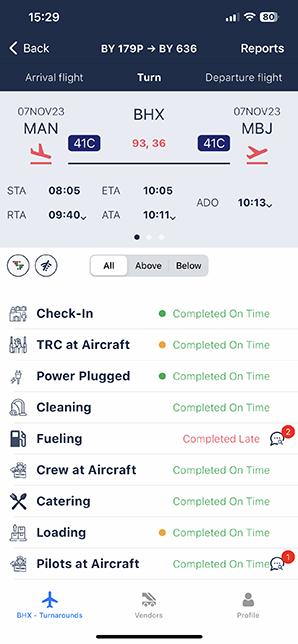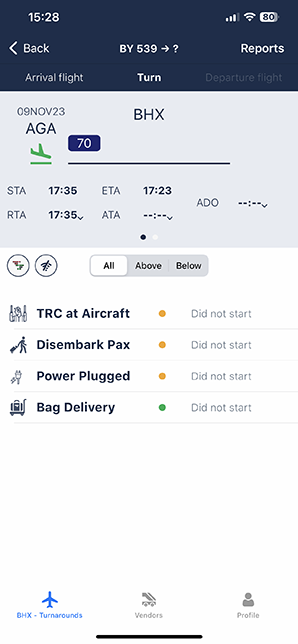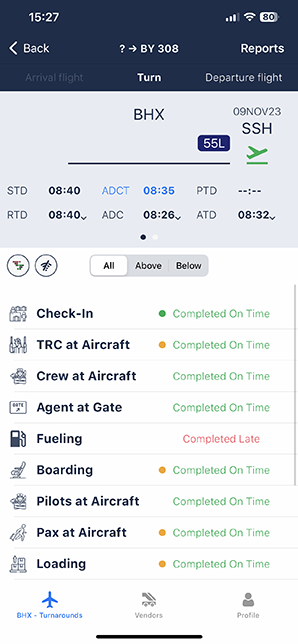Revolutionizing airline ground ops: TUI's Turnaround Tool success story
In the world of aviation, even the smallest improvements can have a significant impact on the passenger’s journey, and on the airlines bottom line. Here’s the story of how TUI has created and implemented the TUI Turnaround Tool (TTT), and integrated Schiphol’s Deep Turnaround data for higher data quality. Discover how the TTT is making behind-the-scenes operations smoother, more efficient, and ultimately, a key player in enhancing passenger experiences.
Can you tell me what the TUI Turnaround tool is?
The TUI Turnaround Tool (TTT) is a digital platform developed in collaboration with TUI’s supplier Tarmac Technologies. It is developed to get insight into the status of ground handling activities. The platform enables real-time monitoring of various critical aspects of an aircraft's turnaround process while it is on the ground. This includes activities such as boarding, cleaning, and other ground handling procedures. The insights allows stakeholders, including TUI’s Amsterdam Duty Managers to monitor the operations at the station. We’re also planning to roll it out to TUI's Operations Control Center (TOCC) in the United Kingdom, to observe live activities at various airports, even when they are not physically present on-site. The TTT also plays a crucial role in data analysis. We can now process the collected data to identify trends, areas for improvement, and potential issues that may lead to delays or operational challenges.
Where does the data in the TUI Turnaround Tool come from?
At Amsterdam Airport, we’ve integrated the real-time information from Schiphol’s Deep Turnaround. It’s AI algorithm interprets images taken by camera’s at every gate in Amsterdam. We use Deep Turnaround to automatically generate timestamps for every flight, such as catering services, fuelling, baggage and more (editor’s note: data generated with Deep Turnaround is available through Schiphol’s API platform). At airports without Schiphol’s system, the dispatchers and load masters of the ground handlers can manually input data in the platform, in real time. That’s already a big win. For some flights, our Station Operations Coordinator supervises certain flights and enters the data into the tool.
Where do you use the TUI Turnaround Tool?
The TTT was rolled out mid-June 2023 and is now used at Amsterdam, Birmingham, Brussels, London Gatwick, and Manchester. We will continue the rollout of this tool at our key stations while we start using the valuable data already gathered for a more data driven supplier management.
What led to the creation of the TUI Turnaround Tool?
The development of the TTT was primarily driven by our strategic push to enhance digital operations within ground services. We want to provide greater visibility into aircraft turnarounds so that we can take better decisions. When an aircraft is in the air, there is is a lot of data available, such as flight radar and ADS-B. However, once the aircraft is on the ground, it's essentially a blind spot, except for the people who are physically present. TUI's idea, similar to Schiphol’s vision with Deep Turnaround, was to change that by capturing what is happening on the ground, and immediately putting that into a dashboard visualising all ground operations. This allows our TOCC in the United Kingdom to monitor live activities, enabling duty managers and handlers to make informed decisions, follow flight plans, and even predict and respond to ground situations efficiently.
With the integration of the Deep Turnaround API, I can rely on a true source of data that captures all the processes happening around the aircraft. In combination with the TUI Turnaround Tool, we can purely focus on the processes above the wing.
The Deep Turnaround API helps us in monitoring what is currently happening at the aircraft. It gives us an extra set of eyes on the ground. Before, this communication happened mostly via the phone. Now we are able to see what is happening for almost all of our crucial process in the tool, with the help the Deep Turnaround.
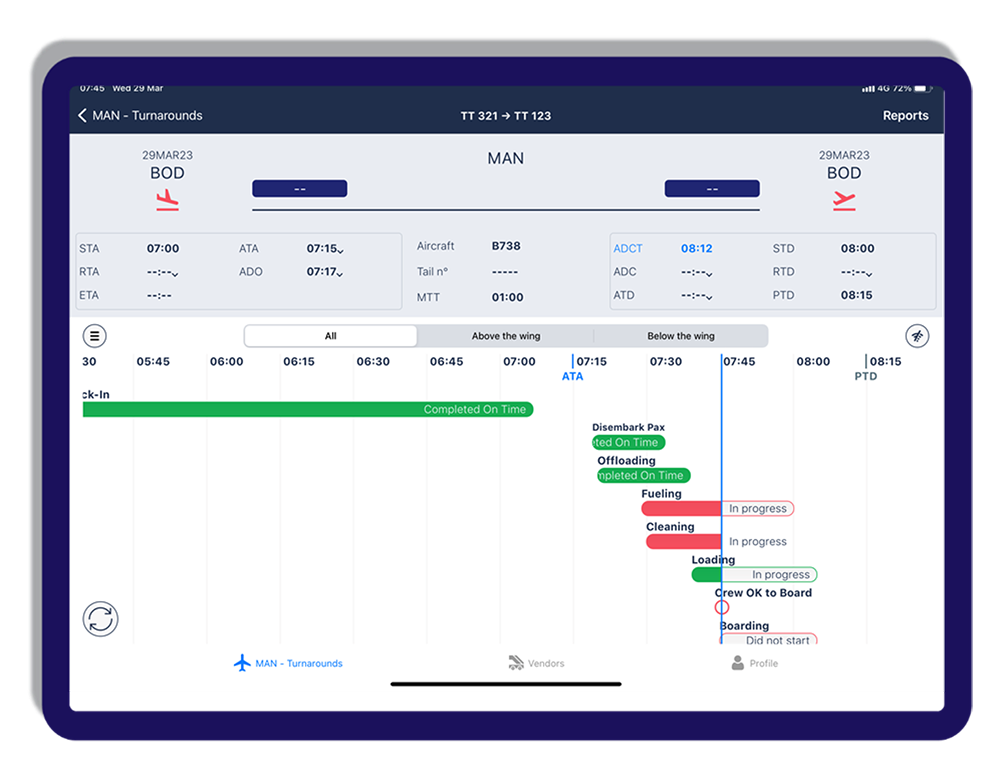
What can you already say about the success of the TUI Turnaround Tool
Accurate data is absolutely critical and that’s what we’re starting to get. Accurate data forms the basis for sound decision-making. Inaccurate data can lead to flawed decisions, so it's crucial that the data entered into the system is correct. This ensures that our analyses are accurate, and trends can be identified reliably.
How does Schiphol’s Deep Turnaround solution help you with accurate data and create value?
The benefits are substantial. In Amsterdam, we have a wealth of accurate automatic data points, the TTT & Deep Turnaround combination has significantly reduced the workload for personnel responsible for data entry. It also provides us with better visibility into operations, allowing us to identify trends and areas for improvement much earlier. It’s very relevant for the duty managers at the local APOC, to identify delays, earlier. They can adjust flight plans and already notify passengers and colleagues in the destination airport. It helps them to understand what is going wrong, and how long it will approximately take.
It will save a lot of phone calls from the moment we have it rolled out at the TOCC. Because instead of having to make a phone call from Amsterdam to the United Kingdom to update them about delays, they can look at the screen and think – “Hey, fuelling hasn’t started yet, that looks like a possible delay”. So it saves us manual work and we’re more on top of things.
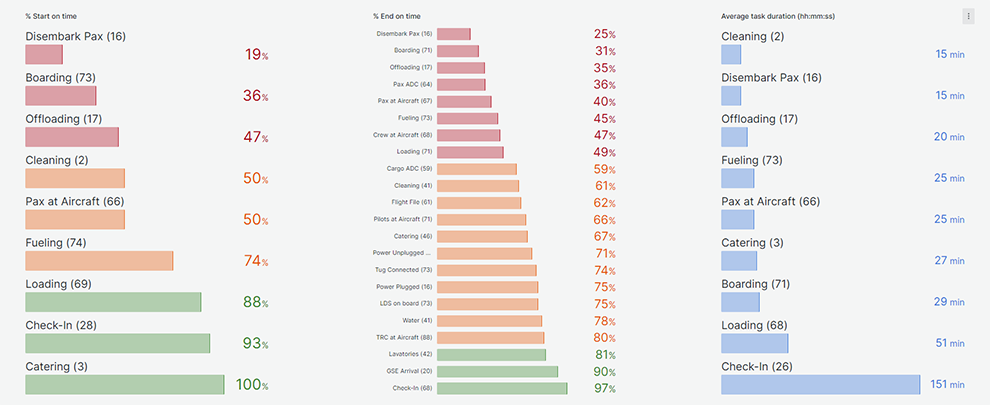
How were things done before you rolled out the TUI Turnaround Tool
Before the TTT we didn’t have a good insight into the ground operations. Many handlers relied on the Load Master to use traditional pen-and-paper methods to record and track various events. Obviously this doesn’t provide our key operational stakeholders with live-insights. Not having these live turnaround insights creates a situation where we’re always reactive, instead of proactive. For example. If we know about a delay in the turnaround, early, we could notify passengers earlier that boarding will be delayed. The introduction of the TTT marked a shift towards digitalisation and automation, addressing our challenges and enhancing the overall efficiency and transparency of ground operations.
Can you share some examples of how this improved data analysis has been applied in practice?
With the TTT, we can quickly spot trends and issues. For instance, if we notice that cleaning processes are consistently delayed at a particular station, we can work with the ground handler to find solutions. We can also analyse data per destination or flight type to determine where improvements can be made to reduce delays and enhance customer satisfaction. When things were done on paper, we couldn’t do that because either the data wasn’t there, or by the time we did get the data, circumstances had already changed which made the data irrelevant to the situation. Now, we can use the data immediately in our daily review calls.
What's next in terms of innovation and digitalization in ground operations?
At TUI, we are committed to transforming our operations through innovative and digital solutions. We adapt to evolving industry trends and customer needs through future-oriented and data driven solutions.
Subscribe to Aviation Solutions updates:
Discover what we're up to and receive a quarterly digest of everything related to Aviation Solutions.
Read the previous blogs
-
The Amsterdam Delay Allocation Method explained
Published on:Here’s how airports can improve delay insights by using already available data to get a deep understanding of the delay breakdown, enabling improvements.

-
Menzies’ 365 days with Deep Turnaround
Published on:Menzies Aviation shares their insights on how they transformed airport efficiency and communication with Schiphol's Deep Turnaround system over the past year.

-
Deep Turnaround featured on Future Airport
Published on:Future Airport's feature highlights Schiphol and Eindhoven Airport for their adoption of Deep Turnaround tech, revolutionizing airport operations.

